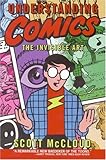Understanding Comics: The Invisible Art
This book was part of my buying spree based on the excellent Ask Metafilter post: What single book is the best introduction to your field (or specialization within your field) for laypeople?. There are wonderful suggestions in that discussion, and I narrowed down the suggestions to four books.
This was the first of the four I finished. (I read this a while ago, as you can tell by the create date of the doodle I drew after finishing it.) It was surprisingly deep and informative. I was going to say "for a comic book," but that would not be fair, especially after reading and understanding Scott's view of comics. While there are plenty of simple and uninteresting comics, there are just as many uninteresting books, movies, and operas. Meaningful art has little to do with the medium and everything to do with the messenger and the message. Comic books are no less art than novels or plays. But I will return to that in a moment.
The first part of the book discussed the meaning and history of comics. Scott ventured back in history to where comics began to take the reader through their evolution. This is where he arrived at his definition for comics: “juxtaposed images in deliberate sequence intended to convey information or produce an aesthetic sense” (this is the paraphrased definition I used in my doodle when the full definition didn’t fit in the bubble. The actual definition is a bit longer—regrettably, I don’t have Scott’s book in front of me).
The second part explained the mechanics of comics. He moved through how motion occurs between static frames, how color is used, and the basics of symbols: how simplifying a drawing transforms them from mere photographic reproductions to iconic representations that move beyond the mere objects they represent. In other words, the act of simplification actually imparts more meaning on the images.
The most enjoyable part of the book, however, was toward the end. He goes through what it means to be a true artist. He described the different levels of comic book artists. The Dreamer: a child who reads comic books and wants to write them, but doesn’t put in much time or effort and gives up her dreams early. The Dabbler: she draws comics as a hobby, spends a lot of time doodling, but never moves beyond the hobby level. The mechanic: she works hard and becomes an artist, but a low-level artist, who draws or inks comics for other artists. The Expert: she moves past the low-level artist and even writes and draws her own comics, but she never takes risks. She tells the same stories in the same styles as the other artists who came before her. She may be monetarily successful, but she is not, The True Artist: she makes it to the Expert level, but decides to take a risk and push the current boundaries of comics. She creates her own styles and modes of storytelling. She moves the art form forward, not by relying on how others do it, but by taking risks and moving beyond what others accomplish. She sometimes fails, but when she succeeds, the comic world is changed.
I’ve not done Scott justice on this part. I had to read this chapter twice as I love reading this philosophy. It’s similar to what I learned from my former boss (and to a much lesser and flawed extent, Ayn Rand): it’s the independent risk taker that succeed or fail miserably in any worthwhile endeavor, whether it be succeeding in business or creating true art. To change the world means to move beyond how the world currently is. All great artists and people do this. This is what makes people truly great.
Scott ends with his thoughts on the future of comics. He believes that we are on the edge of a new interest in this art form: Society is poised to accept comics like paintings, novels, and television before it. Reading his book, I cannot help but agree.
Even for a person who has no interest in reading or creating comic books, this is an excellent book. It’s useful to understand different art forms, and develop an appreciation, if not a love, of comics.

